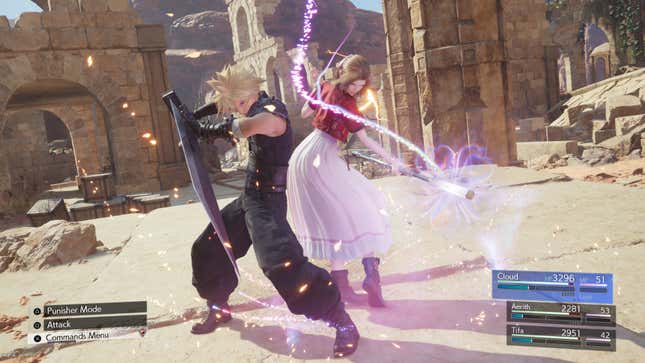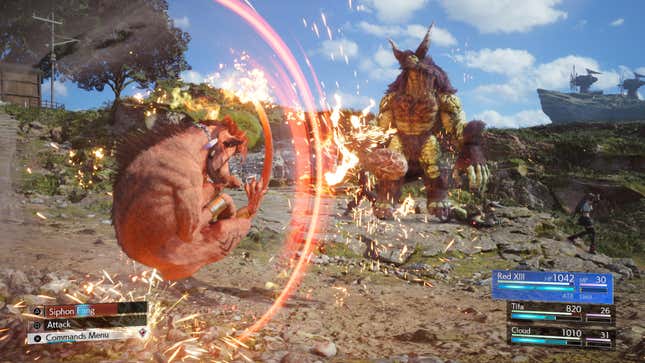Ever since the launch of Final Fantasy VII Remake back in 2020, fans of the original have been wondering how the next installment of Square Enix’s reimagining of the landmark 1997 game would handle the many iconic setpiece moments, reveals, and twists yet to come. The Nibelheim Incident, which centers around Cloud’s consequential return to his hometown five years earlier, has been an especially fertile ground for speculation. The original game and its many spinoffs revisit this mission numerous times to show off the varying perspectives of the key players. It’s an overused analogy, but The Nibelheim Incident is essentially FF7’s equivalent of the Rashomon murder scene. With each slightly different retelling, we inch a little bit closer to the truth.
FF7‘s save-the-world story wasn’t revolutionary in 1997, and it certainly isn’t today. But the palpable sense that something is “off” with Cloud and his mentor-turned-nemesis Sephiroth elevates it into something far more memorable and enduring. For much of the game, the fate of the planet kinda takes a backseat to finding out what the deal is with these guys. At the same time, with Final Fantasy VII Rebirth, the developers at Square Enix face the daunting task of attracting newcomers to the second chapter of a trilogy, those who may primarily know Cloud and Sephiroth as cool badasses with fun hair from the Super Smash Bros. Ultimate roster.
So when I booted up the game at a recent media preview event, I was delighted to see that Chapter 1 of Final Fantasy VII Rebirth immediately begins with Cloud telling his version of what happened at Nibelheim. Rebirth throws you in at the deep end and delivers high stakes right up front—and it’s exactly what longtime fans want and newcomers need.
Pre-order Final Fantasy VII Rebirth: Amazon | Best Buy | Target

Déjà vu all over again
I’d played a smaller segment of this section at a preview event a few months back, but that slice was more combat- and traversal-focused. True to the original game, the full version of Rebirth’s Nibelheim incident is a slow burn, a cozy evening with friends winding down after the frantic escape from Midgar. Present-day Cloud narrates over this extended interactive sequence where you play as his younger self, and his storytelling is punctuated by interruptions from Barrett, Tifa, and Aerith. Many of these exchanges are taken beat-by-beat from the original game, and it’s nice to see them return here to inject some levity and sense of camaraderie into Cloud’s suspenseful and gloomy story.
Rebirth’s take on Nibelheim largely sticks to that of the original FF7. (Mostly.) The reason for Cloud and Sephy’s mission remains the same—they’re sent to investigate a malfunctioning mako reactor at Mt. Nibel, and deal with any monsters along the way. We get a clearer sense of Sephiroth’s renown and celebrity—we’re mostly told, not shown this in the original—as townsfolk breathlessly gossip about him and jostle for photos. As before, you get the chance to control Sephiroth in combat during the climb, and he’s absurdly strong and fun to play.
Ascending Mt. Nibel functions as a light tutorial for Rebirth’s new traversal mechanics, including jumping and climbing. It’s nothing complicated, but it does convey that Mt. Nibel is dangerous enough to require a guide’s assistance better than the original game did. Speaking of guides, we get quite a bit more of young Tifa in this section of Rebirth (Nibelheim is her hometown too, after all), complete with her adorable cowgirl outfit. And there are some very intriguing consequences of that, which I am not going to get into here.
On that note, Chapter 1 of Final Fantasy VII Rebirth is a veritable bonanza of jaw-dropping spoilers for folks who haven’t played the original game. Despite knowing exactly what was coming at certain moments, the impeccable visuals and environmental design blew me away. And, as was the case with Remake, when Rebirth’s soundtrack is firing on all cylinders, it’s the stuff of real-deal goosebumps on your arms. As the flames reach higher and the music shudders like a terrified heart, suddenly I’m 11 years old again, sitting cross-legged on the floor next to my older brother in front of a CRT with a skateboarding sticker on the side, unable to say anything but whoa.

A whole new world
After Cloud gives his friends the rundown of what happened with Sephiroth in Nibelheim, we resume the present-tense story in the city of Kalm. And golly, what a glow-up. In 1997’s FF7, the town was little more than an RPG gas station—a place to pick up some potions, cheap equipment, and a quick snooze at the inn. There was never much reason to go back once you’d progressed to other places. This time around, its cobbled streets, overgrown flower boxes, and rabbit-warren layout ooze a tranquil charm that’s worthy of the name.

You won’t spend too long here in Rebirth either, but it does provide a chance to get acquainted with several new gameplay additions. The most notable of these are party relationships and party level, which allow you to strengthen your bond with your teammates through dialogue choices and optional activities. The original FF7 had a less fleshed-out version of this that culminated in the infamous Gold Saucer date, and it’s nice to see that the devs are finding new ways to let players spend more time with their favorite characters.
The innkeeper at Kalm will introduce you to Queen’s Blood, Rebirth’s answer to card games like Witcher 3‘s Gwent and FF8‘s Triple Triad. I can already tell loads of people are going to be utterly obsessed with this minigame, though I sadly am not one of them. (Happy for you guys, though!) This section also offers a brief rundown of skill trees, weapon upgrades, and item crafting. I remain unconvinced that Final Fantasy 7 needed a crafting system, and I didn’t find much occasion to use it during my demo. I can see how it may be useful for some optional fights later on, but I hope it’s more of a “take it or leave it” mechanic.
But we can’t stay in Kalm for long, and it’s soon time for our merry band of weirdos to hit the road in search of adventures, pocket money, and eventually Sephiroth. Rebirth’s version of the original game’s vast open world is bigger and more beautiful than I’d hoped, with plenty of nooks and crannies to explore. You’ll gain access to both menu-based fast-travel and chocobos pretty much immediately after leaving Kalm, mercifully cutting down on the ponderous backtracking of the 1997 game. Instead of large swaths of empty space for random encounters, now there are small farms, hamlets, and ruins between cities and dungeons. This makes Rebirth’s open world feel like a natural expansion of scope rather than just a concession to the expectations of fans. After hitting up the Chocobo Farm, you’re free to explore for a while, but once you’re ready to return to the main story, a Ghost of Tsushima-esque green Mako trail will appear to nudge you toward your destination. It’s a thoughtful design choice that avoids the immersion-breaking “map game” vibes that have become a bit too commonplace in open-world design.

Naturally, once you get out into the big wide world, you’re gonna be doing some fighting. Final Fantasy VII Rebirth adds another layer to Remake’s real-time combat system, and I’m still not totally sure how I feel about it. You’ll have more than three party members to choose from at any given time, and each unique duo or trio can team up for a unique special attack. On paper, this sounds like Chrono Trigger, which is terrific. In practice, it kinda feels like one thing too many to keep track of. Remake’s combat had a satisfying cadence of managing cooldowns to pull off magic spells, heals, and special attacks. But in the early hours of Rebirth, even mundane fights have a noticeably stop-start feel to them. I’m hoping to settle into a flow eventually, but I’m also curious if this all might feel better in classic, turn-based mode instead. (Thankfully, it’s an on-the-fly toggle in the full game.) Quibbles aside, I’m still enjoying the heck out of the combat and the demo left me hungry for more. Pro tip: Red XIII’s strangely Sonic Spinball moveset is extremely fun to play.
The big question heading into Rebirth and its unnamed successor is: can it recapture—or even exceed—the magic of the original game? That remains to be seen. But, so far, the first three chapters are a helluva good sign for what’s to come.
Final Fantasy VII Rebirth launches February 29 on PlayStation 5.
Pre-order Final Fantasy VII Rebirth: Amazon | Best Buy | Target
.

